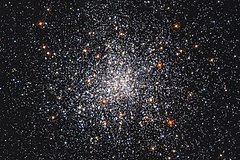Messier 79
(c) ESA/Hubble, CC BY 4.0 Gromada kulista M79 (HST) | |
| Odkrywca | |
|---|---|
| Data odkrycia | 26 października 1780 |
| Dane obserwacyjne (J2000) | |
| Gwiazdozbiór | |
| Typ | klasa V |
| Rektascensja | 05h 24m 10,59s |
| Deklinacja | –24° 31′ 27,3″ |
| Odległość | |
| Jasność obserwowana | 7,7 m |
| Rozmiar kątowy | 9,6' |
| Charakterystyka fizyczna | |
| Wymiary | Ø 118 ly |
| Alternatywne oznaczenia | |
| NGC 1904, GCl 10, C 0522-245, 1E 0522.1-2433, [V2001] NGC 1904 X01 | |
 Konstelacja Zająca | |
Messier 79 (M79, NGC 1904) – gromada kulista w gwiazdozbiorze Zająca. Odkrył ją 26 października 1780 Pierre Méchain. Od 17 grudnia 1780 w katalogu Messiera. Jako gromada kulista M79 została rozpoznana przez Williama Herschela (około 1784).

M79 znajduje się w odległości około 42,1 tys. lat świetlnych od Ziemi i oddala się z prędkością ok. 200 km/s. Od centrum naszej galaktyki dzieli ją około 60 tys. lat świetlnych. Średnica gromady wynosi ok. 118 lat świetlnych.
Znanych jest 12 lub 13 gwiazd zmiennych należących do gromady M79.
W 2003 odkryto, że gromada ta może pochodzić z galaktyki Karzeł Wielkiego Psa. Oprócz M79 podobne pochodzenie miałyby mieć obiekty NGC 1851, NGC 2298 i NGC 2808.
Bibliografia
- Messier 79 w SEDS.org (ang.)
- Messier 79 w bazie SIMBAD (ang.)
Media użyte na tej stronie
(c) ESA/Hubble, CC BY 4.0
It’s beginning to look a lot like Christmas in this NASA/ESA Hubble Space Telescope image of a blizzard of stars, which resembles a swirling storm in a snow globe.
These stars make up the globular cluster Messier 79, located about 40 000 light-years from Earth in the constellation of Lepus (The Hare). Globular clusters are gravitationally bound groupings of up to one million stars. These giant “star globes” contain some of the oldest stars in our galaxy. Messier 79 is no exception; it contains about 150 000 stars, packed into an area measuring just roughly 120 light-years across.
This 11.7-billion-year-old star cluster was first discovered by French astronomer Pierre Méchain in 1780. Méchain reported the finding to his colleague Charles Messier, who included it in his catalogue of non-cometary objects: The Messier catalogue. About four years later, using a larger telescope than Messier’s, William Herschel was able to resolve the stars in Messier 79 and described it as a “globular star cluster.”
In this sparkling Hubble image, Sun-like stars appear yellow-white and the reddish stars are bright giants that are in the final stages of their lives. Most of the blue stars sprinkled throughout the cluster are aging “helium-burning” stars, which have exhausted their hydrogen fuel and are now fusing helium in their cores.Autor: Oryginalnym przesyłającym był Blueshade z polskiej Wikipedii, Licencja: CC-BY-SA-3.0
Ta mapa gwiazdozbioru została stworzona przy pomocy programu PP3 autorstwa Torstena Brongera. Tłumaczenia na język polski oraz innych modyfikacji na potrzeby polskiej Wikipedii dokonał Przemysław 'BlueShade' Idzkiewicz. Grafika udostępniona jest na licencji GFDL w wersji 1.2 lub nowszej.
Messier 79 on GALEX sky survey



